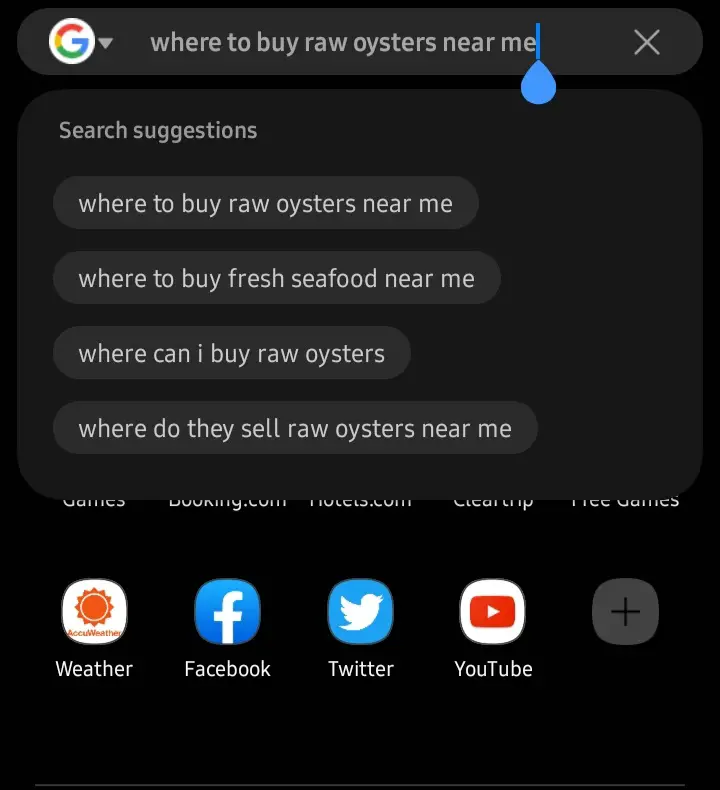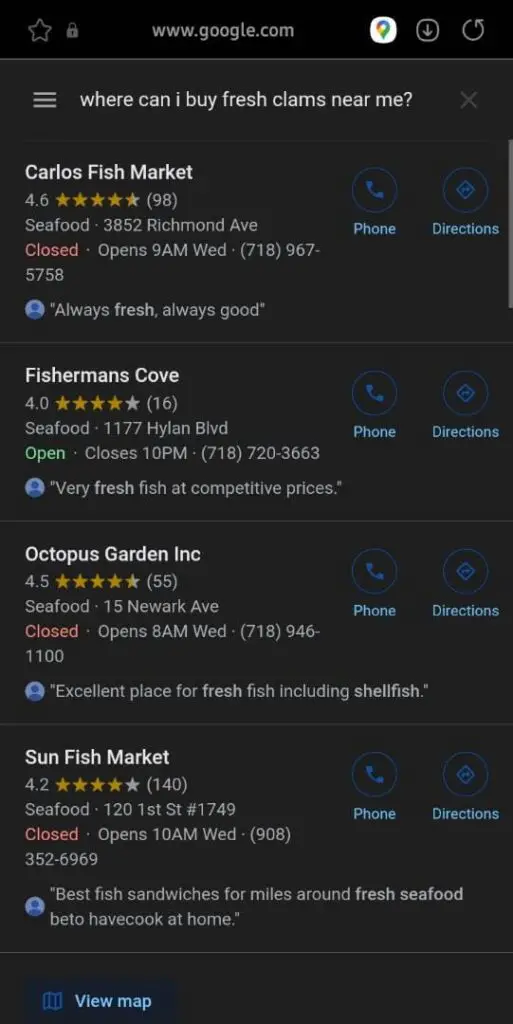Oysters are a full option when it comes to nutrients; they still retain their nutrients and flavor after being stewed, baked, broiled, or steamed. They contain low fat and calories and are very rich in zinc, protein, copper, phosphorus, potassium, vitamin A, B12, and calcium.
Getting oysters near you should not be an issue if you have a data plan and, of course, a mobile device that can navigate the Internet.
Following the steps below should help you locate the nearest market or store where you can buy raw oysters.
- Search for “Where to buy oysters near me”. You can put in your phone’s location or your browser will set it up automatically.

- Select “Maps.”

- You have the option to view it on the map or list view
- The map view

- The list view

- The page opens with a tap on any market or store.

- You can scroll through reviews and ratings to see what other buyers are saying.
- If you find someone within your budget, you can call or follow the list of options that you can use to contact them.

Note: the steps can be followed by mainly mobile device users. However, if you use a computer, it can still serve as a guide to be used with the browser.
What to look for when buying oysters?
Oysters are widely regarded as one of the most popular types of seafood. However, not everyone that sells oysters knows how to preserve them, so you might end up buying an infected or dead oyster.
- When purchasing oysters, the first thing to look out for is the smell. The smell should be clean, marine, and neutral. Any strong, pungent, or funky odor should not be accepted.
- Do not buy oysters sold in tanks. The brine is the reason why the taste remains fresh. When oysters are put in a tank, the brine mixes with the water and loses its taste. And you do not even know how clean the tank water is, especially if you are consuming the oysters raw.
- Broken shells, oyster meat freshness
- Confirm whether they are dead or alive by gently tapping the shell. If it remains open (even if it’s slightly), do not buy.
After selecting the best oysters on the market, consumption should start with the best, biggest, and most attractive. Oysters do not stay fresh for more than 24 hours. Eat from the best down to the least attractive.
Do you cook oysters or eat them raw?
There is no doubt that most seafood is richly packed with nutrients and makes us have a healthy lifestyle. Oysters are usually consumed raw by some people with a few drops of lemon juice. Consuming it raw provides the body with abundant minerals and vitamins, which contribute to maintaining a healthy brain.
We strongly recommend that oysters be cooked before eating. Here’s why:
Vibrio parahaemolyticus, also known as vulnificus, is a bacteria found in oysters found in warm coastal areas. These bacteria do not necessarily affect the smell or appearance of the oyster. However, if you get symptoms like diarrhea, abdominal pain, skin lesions, fever, and vomiting after a few days of eating a poorly cooked oyster, make sure you see a doctor.
Undercooked shellfish is extremely unhealthy and can harm the body’s systems, regardless of whether it was purchased raw and fresh. Make sure you allow the oysters to cook properly before eating them.
Can I eat raw oysters from the grocery store?
Raw oysters are usually still alive or fresh when served. Oysters that were no longer alive before are not healthy anymore. This is because dead oysters are suitable habitats for bacteria.
If you got the raw oysters from the grocery still alive, you can eat them raw. However, if they have been pre-shucked, make sure you cook them properly before consuming them.
In summary, meat purchased from grocery stores should not be eaten raw. After shucking oysters, they should be eaten within 24 hours.
How do you properly eat an oyster?
If you are one of those people who eats oysters from the shell, this should help you a lot. Let me help you with some basic rules for eating oysters.
- Before using your mouth on the shell, use a fork to loosen the meat and suck.
- Just swallowing the oyster without chewing shows you do not enjoy it. You have to be deliberate about chewing the oysters. Chewing slowly helps you enjoy the seafood better.
- Consume the liquid contained within the shell. It gives you the full marine effect.
- When you are done with a shell, turn it upside-down.
These are ways you can properly eat a raw oyster while enjoying every moment of it. You can also use mignonette, although many believe that the flavor of the oyster is masked by it. Use a drop of lemon juice then!
What drink goes with oysters?
Contrary to popular belief, oysters taste great when given a finish with wine. Some wine pairings are taken and usually enjoyed selectively by the pros. If you enjoy using basic lemon juice, it’s still okay.
Here are some wines you can pair oysters with.
- Picpoul Blanc
- Dry Aussie Riesling.
- New Zealand Sauvignon blanc
- Sauternes
- Fino Sherry
- Sancerres grown
- Challis
- Muscadet
- Champagne
- Methods Ancestral
- Crémant d’Vouvray.
Champagne has its special way of combining with oysters. Carbonated champagne provides a sparkling taste when balanced with the creaminess or milky taste of oysters.
How can you tell if oysters are fresh?
Below is how you can recognize an oyster no longer suitable for consumption.
- 1.Check for broken shells or cracked areas. Shells usually have a glossy white color with streaks of gray or pink. Dispose of any oyster with shell problems.
- 2. Gently tap the shell to identify a dead or bacteria-infected oyster. If it closes tightly, it is fresh.
- 3. Examine the oyster meat. It should look plump and glossy. Oysters that are black, pink, or brown should be disposed of.
- 4. A healthy oyster should have a sea fresh smell that is mild. A pungent, strong, fishy, or offensive odor means it is bad.
Oysters that have been removed from the shells or shucked before being bought should not be consumed raw. Make sure you cook it thoroughly before you eat it.
How do you prepare raw oysters to eat?
Preparing oysters should not be a big deal. After washing them, prepare your towel, cutting board, and sharp knife.
Below is how you can prepare raw oysters for consumption.
- 1. spread the towel on a surface and keep the oyster on it
- 2. Keeping the knife at a 45° angle. Apply pressure with your hand to open the oyster. Wiggle the tip of your knife into the hinge.
- 3. Twist and wiggle the knife when you are about a quarter of the way into the shell. Do this until the hinge pops.
- 4. Release the top shell by cutting the abductor muscle under the top shell.
- 5. Use the knife to release the oyster by running the knife under the meat.
- 6. Check to see if there is any shell in the oyster.
It can be served with a mignonette sauce (this is a French sauce made with minced shallot, cracked black pepper, and red wine vinegar), hot sauce, and lemon juice (lemon juice is the most commonly used).
What are the benefits of eating raw oysters?
Oysters are freshly flavored, chewy and distinctive when consumed raw. People who eat raw oysters always have this delightful expression on their faces after taking a bite.
Apart from the flavor, let’s take a look at how it contributes to your health.
- 1. Vitamin B12 found in oysters replenishes the brain’s health and prevents Alzheimer’s disease and dementia.
- 2. Micronutrients like copper, zinc, manganese, and vitamin D found in oysters improve bone density and prevent osteoporosis.
- 3. Oysters provide the body with selenium, which is needed in small quantities to prevent deficiencies like cognitive decline, infertility, and cardiovascular disease.
Generally, raw oysters provide the body with a great deal of iron, vitamin D, selenium, copper, zinc, phosphorus, manganese, magnesium, and iron. A full option, right? You can also get the same value from the cooked oysters.
How often should I eat oysters?
Oysters have this special taste that can be compared to candies, wine, or coffee. You can never get enough oysters once you eat them. They could be addictive just like any other delicious snack.
If you must eat oysters, do it just two times a week and make sure you do not eat a dozen oysters in one sitting. Six oysters should be okay if you are eating it as a main dish, and three oysters should be okay as an appetizer.
As the saying goes, “too much if everything is bad.” Consumption of too many oysters is very dangerous for your health. This is because they contain zinc, which should not be taken in excess. Zinc overrides the iron and copper in the body and drastically reduces them, causing anemia and impaired immune functions.
